Holding Management. Cash Flow Planning
The functionality for this article was reviewed using 1C:Holding Management release 3.2.3.58
The Treasury subsystem in 1C:Holding Management is designed to automate the accounting and management of financial operations of the holding. It allows you to control cash, make payments, account for financial transactions and analyze the financial condition of the holding.
Within the Treasury subsystem, you can create and approve payment orders, generate payment documents, control the execution of payments, and also keep records of cash transactions and transactions with bank accounts.
In addition, the subsystem allows for the automation of liquidity management processes, optimization of financial flows and improvement of the efficiency of holding financial management.
In general, the Treasury subsystem in 1C: Holding Management helps organizations effectively manage financial resources and ensures transparency and control over the financial operations of the holding.
In this article, we will consider the stage of planning payments and receipts. And in this direction, it is worth highlighting the following key topics:
What documents can be used to plan cash flow for the payment calendar;
How to set up automatic creation of planning documents;
How to set and adjust limits on cash withdrawals.
Cash flow planning documents
1C:Holding Management provides 2 documents for cash flow planning:
Using these documents will allow you to properly plan and balance the cash flow in the payment calendar in the future.
Let's take a closer look at both documents and the specifics of filling them out.
Application for payment
The main document for planning the expenditure of funds, which has an appearance and requisite composition similar to a payment order.
The payment request journal is located: Treasury – Corporate Treasury – Payment Requests.

The “Main” tab is used to fill in the main payment parameters: transaction type, payer, recipient, agreement, amount, planned date, payer and recipient bank accounts. The “Limit source” field is filled in if a part of the limit was previously reserved for the planned payment (the “Reservation” document was created). More details on limiting the spending of funds will be discussed later.

The hyperlink “Awaiting execution” is of great importance on this tab. When you click on it, a window opens with a choice of the planned date and bank account for debiting. And if similar details on the “Main” tab are the vision of the payment initiator, then in the “Application execution” window – this is the vision of the treasurer. Additionally, in this form, the application can be divided into several payments. It is the filling of this form that will affect the reflection of the application in the payment calendar.

On the “Accounting and Planning Analytics” tab, management analytics of the planned payment are filled in:
general payment analysts (CFO and project);
distribution of the payment amount by VAT items with filling in the article analytics and VAT rates (in the future, this will allow the total amount to be similarly divided by several VAT items in the payment order).

On the “Supporting documents” tab, you can attach a supporting document for making a payment.

The “Document Control” tab is used to control budget limits and reserves.
Violation of budget limit control indicates the absence of a free limit for this payment.
Violation of budget reserve control indicates the absence of a reserve for this payment.

Planned receipt of funds
This document is used for planning cash receipts and further balancing of liquidity.
The document journal is located: Treasury – Corporate Treasury – Planned Cash Receipts.

Filling out the document of planned receipt of funds is similar to the payment request. The only difference is the absence of the “Supporting documents” tab.
On the “Main” tab, the main parameters of the planned cash receipt are filled in.

The “Awaiting execution” hyperlink is also important here; filling it out will affect the reflection of the receipt in the payment calendar.
In the “Accounting and Planning Analytics” tab, the analytics of the planned receipt are filled in. The total amount can also be divided into several VAT items.

Automatic creation of planning documents
In addition to manual creation of payment requests and planned receipts of funds, 1C: Holding Management provides a mechanism for automatic creation of scheduled tasks. The ability to automatically create payment requests allows payment initiators to avoid manual data entry, and treasury employees to quickly receive accurate information about payments to be made.
Before starting the review of this functionality, let's consider the necessary NSI settings for its correct operation. To do this, select: General reference books and settings” – Settings – Treasury

Next, you need to select the “Contract Management” section, in which we are primarily interested in enabling automatic generation of an application based on payment schedules.

Using the “Schedule” hyperlink, you can set up a schedule for generating documents (triggering a scheduled task); in the “Generate requests for” field, you can select how many days before the planned payment the request will be generated.
After checking the NSI settings, you can proceed to consider the functionality of creating applications. As an example, let's consider 2 possible cases:
Formation of an application for payment under a contract with a supplier with a fixed schedule;
Formation of an application for payment of the principal debt under a loan agreement.
Formation of a payment request under a contract with a supplier with a fixed schedule
To consider this option, let's create a contract with a supplier. In the contract card, on the “Main” tab, select the “With supplier” contract type, fill in the contract amount and all the basic contract information.

On the “Conditions” tab, in the “Settlement Management” field, select “By agreement as a whole”.

On the “Planning” tab, in the “Used schedules” field, select “Only calculations” and fill in the future analytics of the payment request: CFO, project and VAT item.

After clicking the “Settlement Only” button, the “Settlement Schedule” tab appears. Let's go to it and fill in the payment schedule under the contract. Let's add one accrual and three planned payments to the table section.

After entering the payment schedule, the program has all the necessary data to automatically generate a payment request. According to our settings, it should have been generated on 04/01/2024 – 10 days before the first payment on 04/11/2024.
For the purposes of demonstrating the example, we will launch the scheduled task manually. In real work, this operation does not need to be performed, it will work automatically in accordance with the settings. To launch manually, go to: Administration – Program settings – Maintenance.

In the window that appears, in the “Regular operations” section, launch “Regular and background tasks”.

In the list that appears, select “Generate requests according to payment schedules” and click “Execute now”.

Next, we go to the payment request log and see that the request was successfully automatically generated.

Formation of an application for payment of the principal debt under a loan agreement
For this example, we will create a loan agreement with a fixed payment schedule. On the “Payment Schedule” tab, we will fill in the planned accrual and payment schedule.

After this, you can manually run the scheduled task again, and then go to the “Payment Requests” document journal to check whether the required request was created correctly.

The application included all the necessary data on the contract, the type of operation and payment analytics. The planned date was set as the payment date according to the schedule.
Limitation
To control the spending of funds and prevent budget overruns, you can set limits in 1C: Holding Management. This can be done in two ways:
The method of setting using planned budgets relates to the topic of budgeting, so in this article we will consider limiting through operational plans.
The first thing you should start limiting cash expenditure with is enabling limitation by VAT items. To do this, you need to launch “Plan and Limit Management” in the “Planning and Control” subsystem.

In this report, you can set up a cash flow budget and an income and expense budget. For the purposes of this article, we are interested in the first one.
On the “Budget Parameters” tab, you can set the period for which the budget is set, the limit currency, and the system’s reaction to exceeding the limit, which can be as follows:
block the processing of documents (if there is not enough free limit, the program will not allow you to process a payment request);
inform (if there is not enough free limit, the program will issue an informational message, but will allow you to submit a payment request);
do not control (there will be no control over the free limit).

The Budget Items tab displays the VAT item directory, where the parameters set in the previous tab are filled in for all elements. Here, you can individually set up your own parameters for certain items (this may be important if you do not need to monitor some VAT items).

On the “Article Setting Groups” tab, you can combine several VAT articles into a group and set up limiting parameters for it.
After setting up the limiting parameters, you can proceed to entering the planned limits. They are located: Planning and control – Plans and limits – Operational plans.

On the “Basic” tab, you need to select the budget type, period and setup option.

If the operational plan is entered manually, then the setup option will need to be created and the list of limiting analytics and their mandatory nature, as well as the type of planning horizon, will need to be specified.

On the “Planning Data” tab, limits for a certain period of time are filled in item by item. And at this stage, there is a very important nuance.
Important! If “Sliding” is selected as the horizon type in the operational plan setup option, which is used most often in practice (i.e. the planning horizon is shifted every month/quarter, depending on the planning frequency), then when filling in the planning data, you must use the “Fill” button. Clicking this button will “pull up” the unused limit of previous periods. If you start entering new data manually in the operational plan, then such a document will write off “to zero” the unused limits for all items that are not in the document.

If it is necessary to adjust the limit (by “transferring” from one item to another or increasing the overall limit), it is necessary to use the “Application for Adjustment” or “Adjustment” document, where, having selected the required operational plan, you can adjust the limit and send it for approval.
The “Reservation” document allows you to reserve a certain part of the limit. That is, this document does not increase or decrease the amounts in the operational plans, but only “reserves” a certain amount. This can be useful when the payment initiator needs to reserve a part of the limit in advance for a large write-off.





